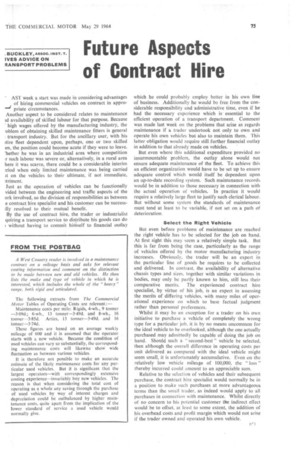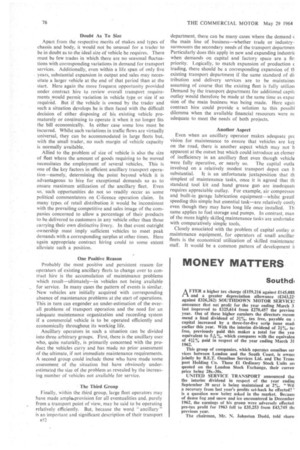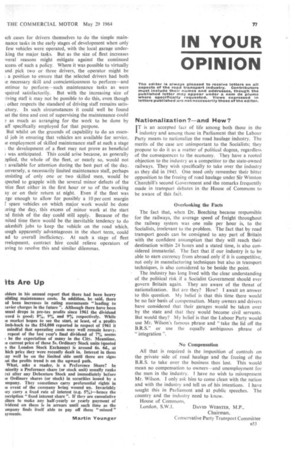Future Aspects of Contract Hire
Page 77

Page 78

Page 79

If you've noticed an error in this article please click here to report it so we can fix it.
AST week a start was made in considering advantages of hiring commercial vehicles on contract in appro./ priate circumstances.
Another aspect to be considered relates to maintenance id availability of skilled labour for that purpose. Because high wages offered by the manufacturing industry, the -oblern of obtaining skilled maintenance fitters is general I transport industry. But for the ancillary user, with his itire fleet dependent upon, perhaps, one or two skilled en, the position could become acute if they were to leave. /tether he was in an industrial area where competition Ir such labour was severe or, alternatively, in a rural area here it was scarce, there could be a considerable interim riod when only limited maintenance was being carried it on the vehicles to their ultimate, if not immediate, :triment.
Just as the operation of vehicles can be functionally vided between the engineering and traffic aspects of the ork involved, so the division of responsibilities as between e contract hire specialist and his customer can be successLily resolved to their mutual benefit.
By the use of contract hire, the trader or industrialist quiring a transport service to distribute his goods can do without having to commit himself to financial outlay
which he could probably employ better in his own line of business. Additionally he would be free from the considerable responsibility and administrative time, even if he had the necessary experience which is essential to the efficient operation of a transport department. Comment was made last week on the problems that arise as regards maintenance if a trader undertook not only to own and operate his own vehicles but also to maintain them. This latter obligation would require still further financial outlay in addition to that already made on vehicles.
But even where this additional expenditure provided no insurmountable problem, the outlay alone would not ensure adequate maintenance of the fleet To achieve this an efficient organization would have to be set up to ensure adequate control which would itself be dependent upon an up-to-date recording system. Such maintenance records would be in addition to those necessary in connection with the actual operation of vehicles. In practice it would require a relatively large fleet to justify such clerical labour. But without some system the standards •of maintenance must tend at least to be variable, if not set on a path of deterioration.
Select the Right Vehicle
But even before problems of maintenance are reached the right vehicle has to be selected for the job on hand. At first sight this may seem a relatively simple task. But this is far from being the case, particularly as the range of vehicles offered by the motor manufacturing industry increases. Obviously, the trader will be an expert in the particular line of goods he requires to be collected and delivered. In contrast, the availability of alternative chassis types and sizes, together with similar variations in bodies, may only be partly known to him, still less their comparative merits. The experienced contract hire specialist, by virtue of his job, is an expert in assessing the merits of differing vehicles, with many miles of operational experience on which to base factual judgment rather than personal preferences.
Whilst it may be an exception for a trader on his own initiative to purchase a vehicle of completely the wrong type for a particular job, it is by no means uncommon for the ideal vehicle to be overlooked, although the one actually purchased may admittedly be capable of doing the job on hand. Should such a "second-best" vehicle be selected, then although the overall difference in operating Costs per unit delivered as compared with the ideal vehicle might seem small, it is unfortunately accumulative. Even on the relatively low vehicle mileage of 100,000, the "loss " thereby incurred could amount to an appreciable sum.
Relative to the selection of vehicles and their subsequent purchase, the contract hire specialist would normally be in a position to make such purchases at more advantageous terms than the small trader, as indeed would apply to all purchases in connection with maintenance. Whilst directly of no concern to his potential customer the indirect effect would be to offset, at least to some extent, the addition of his overhead costs and profit margin which would not arise if the trader owned and operated his own vehicle.
Doubt As To Size Apart from the respective merits of Makes and types of chassis and body, it would not be unusual for a trader to be in doubt as to the ideal size of vehicle he requires. There must be few trades in which there are no seasonal fluctuafions with corresponding variations in demand for transport services. Additionally, even within a life span of only five years, substantial expansion in output and sales may necessitate a larger vehicle at the end of that period than at the start. Here again the more frequent opportunity provided under contract hire to review overall transport requirements_would permit variation in vehicle type or size if so required. But if the vehicle is owned by the trader and such a situation develops he is then faced with the difficult decision of either disposing of his existing vehicle prematurely or continuing to operate it when it no longer fits the bill economically. In either case some loss must be incurred. Whilst such variations in traffic flows are virtually universal, they can be accommodated in large fleets but, with the small trader, no such margin of vehicle capacity is normally available.
Allied to the problem of size of vehicle is also the size of fleet where the amount of goods requiring to be moved necessitates the employment of several vehicles. This is one of the key factors in efficient ancillary transport operation—namely, determining the point beyond which it is advantageous to hire for exceptional demands so as to ensure maximum utilization of the ancillary fleet. Even so, such opportunities do not so readily occur as some political commentators on C-licence operation claim. In many types of retail distribution it would be inconsistent with the prevailing competitive and sales image of the companies concerned to allow a percentage of their products to be delivered to customers in any vehicle other than those carrying their own distinctive livery. In that event outright ownership must imply sufficient vehicles to meet peak demands with a corresponding surplus at other times. Here again appropriate contract hiring could to some extent alleviate such a position.
One Positive Reason Probably the most positive and persistent reason for operators of existing ancillary fleets to change over to contract hire is the accumulation of maintenance problems which result—ultimately—in vehicles not being available , for service. In many cases the pattern of events is similar. New vehicles are initially acquired with corresponding absence of maintenance problems at the start of operations. This in turn can engender an under-estimation of the overall problems of transport operation and the need for an adequate maintenance organization and recording system if a commercial vehicle is to be operated efficiently and economically throughout its working life.
Ancillary operators in such a situation can be divided into three arbitrary groups. First, there is the ancillary user who, quite naturally, is primarily concerned with the product the vehicles carry and has made no prior assessment of the ultimate, if not immediate maintenance requirements. A second group could include those who have made some assessment of the situation but have obviously underestimated the size of the problem as revealed by the increasing number of vehicles not available for service.
The Third Group Finally, within the third group, large fleet operators may have made ample.provision for all eventualities and, purely from a transport point of view, may be said to be operating relatively efficiently. But, because the word " ancillary " is an important and significant description of their transport a52
department, there can be many cases where the demand ( the main line of business—whether trade or industrysurmounts the secondary needs of the transport departmen Particularly does this apply in new and expanding Industrie when demands on capital and factory space are a fir: priority. Logically, to match expansion of production ( trading, there should be a corresponding expansion of tF existing transport department if the same standard of di: tribution and delivery services are to be maintainer assuming of course that the existing fleet is fully utilizer Demand by the transport department for additional capitr outlay would therefore be made at the same time as expar sion of the main business was being made. Here agair contract hire could provide a solution to this possibl dilemma when the available financial resources were n( adequate to meet the needs of both projects.
Another Aspect
Even when an ancillary operator makes adequate prc vision for maintenance to ensure that vehicles are kei on the road, there is another aspect which may not b apparent at the outset but which could introduce an elemer of inefficiency in an ancillary fleet even though vehicle
were fully operative, or nearly so. The capital outla involved on a relatively modest transport depot can b
substantial. It is an unfortunate juxtaposition that th simplest of maintenance tasks, once it is agreed that th standard tool kit and hand grease gun are inadequate requires appreciable outlay. For example, air compressor and built-in garage lubrication equipment—whilst great] speeding this simple but essential task—are relatively cost13 even though they may have long life once installed. Th same applies to fuel storage and pumps. In contrast, man of the more highly skilleekmaintenance tasks are undertake with comparatively simple tools.
Closely associated with the problem of capital outlay maintenance equipment, for operators of small ancillar fleets is the economical utilization of skilled maintenanc staff. It would be a common pattern of development ich cases for drivers themselves to do the simple mainnance tasks in the early stages of development when only few vehicles were operated, with the local garage underling the major tasks. But as the size of fleet increases weral reasons might mitigate against the continued iccess of such a policy. Where it was possible to virtually and pick two or three drivers, the operator might be t a position to ensure that the selected drivers had both te necessary skill and conscientiousness to perform—and mtinue to perform—such maintenance tasks as were ;quired satisfactorily. But with the increasing size of riving staff it may not be possible to do this, even though other respects the standard of driving staff remains satistctory. In such circumstances it could well be found tat the time and cost of supervising the maintenance could e as much as arranging for the work to be done by all specifically employed for that purpose.
But whilst on the grounds of capability to do an essenal job in ensuring that vehicles are available for service, le employment of skilled maintenance staff at such a stage the development of a fleet may not prove as beneficial ; was anticipated. This could arise because, as generally pplied, the whole of the fleet, or nearly so, would not e available for attention during the best part of the day. onversely, a necessarily limited maintenance staff, perhaps msisting of only one or two skilled men, would be cpected to grapple with the several minor defects of the Itire fleet either in the first hour or so of the working ay or on their return at night. Even if the fleet was rge enough to allow for possibly a 10 per cent margin I spare vehicles on which major work would be done uring the day, this excess of minor work at the start ad finish of the day could still apply. Because of the rnited time there would be the inevitable tendency to do takeshift jobs to keep the vehicle on the road which, kough apparently advantageous in the short term, could ad to overall inefficiency. At such a stage of fleet evelopment, contract hire could relieve operators of aving to resolve this and similar dilemmas.




















































































































